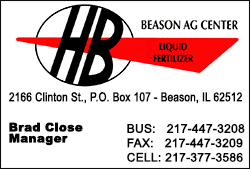|
 Waters of the United States (WOTUS) Rule became effective on
August 28, 2015. Waters of the United States (WOTUS) Rule became effective on
August 28, 2015.
However, on Oct 9, 2015, the Sixth Circuit of the United States
Court of Appeals issued a 'stay' for all of the U.S. on WOTUS Rule.
Various industries including agriculture have stood in opposition to
the Rule primarily because of its lack of clarity, which could
result in giving too much discretion, power and control to
government agencies. Agriculture leaders joined the fight believing
that the Rule could lay a bigger burden on the industry already
heavily laden in regulations.
Concerns from the agriculture industry included the potential for
higher costs, loss of land from production, less effectiveness and
efficiency in production.
The potential impact of the Rule concerned many Logan County
farmers. Some have felt that the EPA is overreaching their power.
For example, though the Act does not specifically regulate ditches,
some ditches meet the definition of tributaries that would be
regulated under the new Rule. Many feel that ditches should be
removed from the definition of tributary.

San Jose farmer Blair Hoerbert said that with the rule, even water
flowing across someone's yard could be under the EPA jurisdiction.
Concerns over waterways and how the Rule would affect farmers
One concern over waterways is the effects of water on soils and
leached soil. An article on "The Problem of Leaching" explains that
"Leaching is the movement of contaminants, such as water-soluble
pesticides or fertilizers, carried by water downward through
permeable soils." The article also states, "In contrast to surface
water, groundwater does not continually dilute the contaminants that
reach it. Flushing a plume of contamination from groundwater may
take many years." These contaminants could possibly move into major
waterways. Some say that nitrogen from fertilizer pollutes rivers,
lakes, and oceans.
Hoerbert said farmers are already working to manage water, nutrient,
and pesticides even without this regulation.
This Rule as written would mean that farmers may need to obtain
National Pollutant Discharge Elimination System permits to apply
pesticides and fertilizers around drainage areas because of the
run-off.
Hoerbert said that getting permits may mean that they could only
spray on certain days, which may cause delays for farmers as they
wait for the permits to be approved.
The ability to use pesticides on livestock in timely fashion has
also been cited by the industry as a concern.
To provide a bit more background of what agriculture leaders have
been fighting, here is an overview and update.
The WOTUS rule adds clarification about what waters may be subject
to the Environment Protection Agency's authority. According to
Evansville, Indiana environmental law attorney, Monica Edwards, this
rule "provide[s] clarity as to which waters are actually subject to
the jurisdiction of the EPA pursuant to the Clean Water Act."

The American Farm Bureau Federation (AFBF) and the National Farmers
Union (NFU) have spoken against the Rule citing areas and
definitions as confusing and lacking in specificity.
American Farm Bureau president, Bob Stallman, identified several
ambiguities in the rule:
"What is a 'water of the U.S.'? Only the agencies can say, and their
word is final. Under the new rule, just about any patch of land
might be found to be 'waters of the U.S.' You don’t have to see
water flowing there, or even spot signs of flow."
Stallman says the rule gives EPA and Corps (Army Corp of Engineers)
the power to use remote “desktop tools” to identify and regulate a
so-called “tributary” on your land—or even just places where a
“tributary” used to be—whether or not you can see anything that
looks like a water feature. What’s more, the rule automatically
regulates other waters within certain distances of any such
invisible or historical “tributary.”
|

These two
farm areas in north central Illinois utilize swales and
grass ways to channel water to low areas and farm ponds.
 |
Stallman pointed at exclusions from regulation, "the one for farm
ponds, apply only to features 'created in dry land.' Was your farm
pond 'created in dry land'? Who knows!"
[to top of second column] |

He said that the pages and pages intended for "'clarity' don’t help
you distinguish between 'waters' and 'dry land.' Only the agencies
can say for sure."
Overall, Stallman says, "The EPA has made it impossible for farmers
and ranchers to look at their own land and know what falls under
federal jurisdiction and what doesn’t. But if the government does
later find that your land is 'waters of the U.S.,' you will already
be in violation of the law for farming there, even though you had no
reason to know your land was regulated."
He says that this puts landowners at risk of steep fines and
concludes, "It’s time for Congress to step in and check EPA’s
blatant overreach. Farmers and ranchers know the importance of
protecting water resources."
Some members of congress have expressed concern about the rules. In
a farm magazine article, "On WOTUS, EPA is taking the law into its
own hands" North Carolina's Republican Representative Mark Meadows
was quoted as saying, "Under the EPA's absurd new WOTUS rule, the
agency would have the ability to regulate waters on private lands
down to ditches, potholes, and puddles."
Industry leaders believe the rule could also affect streams farmers
use for drainage and irrigation even though the EPA document states
that it does not regulate most ditches, groundwater, or tile drains.
According to a National Association of Counties (NACO) Policy Brief,
"The newly proposed rule attempts to resolve confusion by broadening
the geographic scope of CWA (Clean Water Act) jurisdiction." NACO
says, "The proposal states that 'waters of the U.S' under federal
jurisdiction include navigable waters, interstate waters,
territorial waters, tributaries (ditches), wetlands, and 'other
waters.' It also redefines or includes new definitions for key
terms—adjacency, riparian area, and flood plain—that could be used
by EPA and the Corps to claim additional waters as jurisdictional."

At the time the new rule passed on Aug. 28, its employment was tied
up in state courts all across the U.S.
As of Oct. 9th, 2015, judges from Sixth Judicial Circuit Court of
Appeals ordered that the rule not be implemented nation-wide until
the jurisdiction has been more specifically established.
Select excerpts from the judges decision:
["What is of greater concern to us, in balancing the harms, is the
burden—potentially visited nationwide on governmental bodies, state
and federal, as well as private parties—and the impact on the public
in general, implicated by the Rule’s effective redrawing of
jurisdictional lines over certain of the nation’s waters. Given that
the definitions of “navigable waters” and “waters of the United
States” have been clouded by uncertainty, in spite of (or
exacerbated by) a series of Supreme Court decisions over the last
thirty years, we appreciate the need for the new Rule. ... "The
Clean Water Rule is hereby STAYED, nationwide, pending further order
of the court."]
Members of the National Pork Producer's Council (NPPC) are happy
that enforcement of the rule has been temporarily halted. Along with
the American Farm Bureau Federation, they feel that courts need to
better understand how it affects "farmers, ranchers, and landowners"
before enforcing the rule.
NPPC president, Dr. Ron Prestage said, "The WOTUS rule is vague and
fails to let regulated parties know when their conduct violates the
law,. . .We all want clean water, but this regulation is just big
land grab that promotes growth in the size of government and allows
activists to extort and micromanage all kinds of farming and
business activities.”
As the EPA goes back to the drawing board on this Rule, the general
consensus among agricultural agencies, farmers, and even congress
seems to be that the EPA needs to be clear about what it will be
regulating, and make sure it does not adversely affect agricultural
practices.
Related articles:
Springfield field tour to promote benefits of
improved soil health, water quality
Resources and references:
The Final Clean Water Rule
Oct 9th,
2015 -
Court documentation of 'stay' on WOTUS Rule
for all of the U.S.
EPA response to Clean Water Rule Litigation
Statement
Waters of the United States Expanded
Definition and its Impact on Developers and Property - Monica
Edwards
|